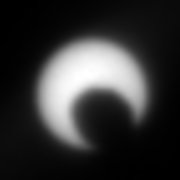Transit of Phobos from Mars
|
|
A transit of Phobos across the Sun as seen from Mars takes place when Phobos passes directly between the Sun and a point on the surface of Mars, obscuring a large part of the Sun's disc for an observer on Mars. During a transit, Phobos can be seen from Mars as a large black disc rapidly moving across the face of the Sun.
The event could also be referred to as a partial eclipse of the Sun by Phobos.
Viewed from orbit, the penumbral shadow of Phobos is observed to move rapidly over the Martian surface, passing over the spots that observe a transit. This shadow on the Martian surface was photographed on many occasions by Mars Global Surveyor and by earlier space probes (see Shadow of Phobos on Mars).
A transit of Phobos from Mars usually lasts only thirty seconds or so, due to its very rapid orbital period of about 7.6 hours.
Because they orbit Mars in low-inclination equatorial orbits, the shadows of Phobos or Deimos projected onto the surface of Mars exhibit a seasonal variation in latitude. At any given geographical location on the surface of Mars, there are two intervals in a Martian year when the shadows of Phobos or Deimos are passing through its latitude. During each such interval about half a dozen transits of Phobos can be seen by observers at that geographical location (compared to zero or one transits of Deimos).
It is easy to see that the shadow always falls on the "winter hemisphere", except when it crosses the equator during the vernal equinox and the autumnal equinox. Thus transits of Phobos happen during Martian autumn and winter in the northern hemisphere and the southern hemisphere, roughly symmetrically around the winter solstice. Close to the equator they happen around the autumnal equinox and the vernal equinox; farther from the equator they happen closer to the winter solstice.
Over the surface of Mars as a whole, there are transits of Phobos somewhere on Mars on most of the days of the Martian year. However, at some intervals in the Martian year the shadow of Phobos is passing north or south of Mars.
Because it orbits so close to Mars, Phobos cannot be seen north of 70.4°N or south of 70.4°S; such latitudes will obviously not see transits either. Observers at high latitudes less than 70.4° will see a noticeably smaller angular diameter for Phobos because they are considerably farther away from it than observers at Mars's equator. As a result, transits of Phobos for such observers will cover less of the Sun's disk.
Mars Rover Opportunity photographed transits of Phobos on March 7 2004 and March 10 2004 and March 12 2004. In the captions below, the first row shows Earth time UTC and the second row shows Martian local solar time.
| Missing image Phobos_Mar_07_2004_from_Opportunity_1.jpg Image:Phobos Mar 07 2004 from Opportunity 1.jpg | 
|
| 02:46:23 08:16:41 | 02:46:33 08:16:51 |

| Missing image Phobos_Mar_10_2004_from_Opportunity_2.jpg Image:Phobos_Mar_10_2004_from_Opportunity_2.jpg | 
|
| 07:36:28 11:04:23 | 07:36:38 11:04:32 | 07:36:48 11:04:42 |

| Missing image Phobos_Mar_12_2004_from_Opportunity_2.jpg Image:Phobos_Mar_12_2004_from_Opportunity_2.jpg | 
| Missing image Phobos_Mar_12_2004_from_Opportunity_4.jpg Image:Phobos_Mar_12_2004_from_Opportunity_4.jpg |
| 13:40:47 15:42:35 | 13:40:57 15:42:44 | 13:41:07 15:42:54 | 13:41:17 15:43:04 |
The data is the tables below is generated using JPL Horizons (http://ssd.jpl.nasa.gov/horizons.html). There is some small discrepancy with the times reported for the series of images above. This may be due to imprecision in the ephemeris data used by JPL Horizons; also the JPL Horizons data gives local apparent solar time while the times reported above are probably some form of mean solar time (and therefore some of the discrepancy would be due to the Martian equivalent of the equation of time).
| Transits of Phobos from Mars Rover Opportunity landing site | |||||
|---|---|---|---|---|---|
| Duration Earth time (UTC) | Duration (Local Solar time) | Minim. separ. | Phobos ang. diam. | Sun ang. diam. | Sun alt. |
| prior set of transits occurred in late April 2003 – early May 2003 | |||||
| March 7 2004 (02:46:25 – 02:46:54) | 08 18 32 – 08 19 00 | 671" | 779.2" | 1230.7" | 34.6° |
| March 8 2004 (01:39:58 – 01:40:31) | 06 35 36 – 06 36 08 | 517" | 665.0" | 1229.8" | 8.9° |
| March 10 2004 (07:36:33 – 07:37:07) | 11 06 16 – 11 06 49 | 114" | 908.4" | 1227.6" | 76.3° |
| March 11 2004 (14:47:15 – 14:47:53) | 17 27 19 – 17 27 56 | 193" | 669.4" | 1226.3" | 8.0° |
| March 12 2004 (13:41:02 – 13:41:38) | 15 44 38 – 15 45 13 | 64" | 784.5" | 1225.5" | 33.7° |
| March 13 2004 (12:30:00 – 12:30:28) | 13 57 16 – 13 57 42 | 625" | 880.4" | 1224.6" | 60.4° |
| next set of transits will occur in the second half of March 2005 | |||||
See also
- Astronomy on Mars
- Shadow of Phobos on Mars
- Transit of Mercury from Mars
- Transit of Venus from Mars
- Transit of Earth from Mars
- Transit of Deimos from Mars
Reference
- J. Bell, M. Lemmon, M. Wolff, Transits of Mars I and II, IAU Circ., 8298, 2 (2004).
[1] (http://cfa-www.harvard.edu/iauc/08200/08298.html)(TeX DVI file is at [2] (http://cfa-www.harvard.edu/iauc/08200/08298.dvi)).
External links
- JPL Horizons (http://ssd.jpl.nasa.gov/horizons.html) (must use telnet interface for non-Earth observation points)
- Opportunity image gallery: Sol 42 (http://marsrovers.jpl.nasa.gov/gallery/all/opportunity_p042.html) (small images of the March 7 2004 grazing transit are near the top of the page).
- Opportunity image gallery: Sol 45 (http://marsrovers.jpl.nasa.gov/gallery/all/opportunity_p045.html) (small images of the March 10 2004 transit are near the middle of the page).
- Opportunity image gallery: Sol 47 (http://marsrovers.jpl.nasa.gov/gallery/all/opportunity_p047.html) (small images of the March 12 2004 transit are near the bottom of the page).
- Animation of March 10 2004 transit (http://photojournal.jpl.nasa.gov/catalog/PIA05553)

